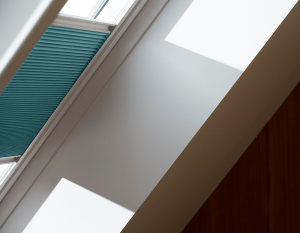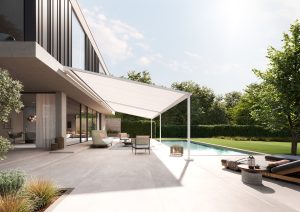Did you know that March 21st is Global Shading Day? The first day of spring is dedicated to celebrating one of the simplest, yet most effective ways to keep our homes comfortable and energy-efficient. This worldwide initiative shines a spotlight on how proper solar shading can help us tackle climate change head-on. Global Shading Day reminds us that sometimes the oldest solutions can be the best approach to modern problems.
UK summers are getting hotter each year, and a record-breaking 40°C was documented in July 2022. Many of us are looking for ways to keep our homes comfortable on those hot days without installing energy-hungry air conditioners. The solution is one that cultures around the world have been using for centuries: solar shading.
Solar shading 101: what you need to know
At its core, solar shading is about controlling how much light enters your living spaces. When it’s too bright or hot outside, you want protection from the elements outside. There are two main approaches to solar shading:
- Installed inside your home – roller blinds, roman blinds, interior shutters, etc.
- Installed outside your home – external venetian blinds, exterior shutters, awnings, and so on.
Today’s options range from traditional hand-operated systems to sophisticated motorised solutions that automatically adjust based on sunlight and temperature. Some even connect to your smart home setup, responding to changing weather conditions without you lifting a finger.
Do you need solar shading in your home?
Not all homes are created equal when it comes to heat vulnerability. Your property might be more susceptible to overheating if:
- You live on the top floor, where heat naturally rises
- Your home has windows that primarily face in one direction, limiting cross-ventilation
- You have large windows facing east, west, or south – catching direct sunlight
In 2021 alone, over 4.6 million UK bedrooms exceeded healthy temperature thresholds. As our climate continues to change, this problem will only grow worse unless we adapt our living spaces.
From ancient wisdom to modern solutions
Solar shading isn’t a new concept. Throughout history, people in hot climates have developed ingenious ways to keep cool.
- Ancient Egyptians hung reed mats over their windows
- Chinese cultures used bamboo screens
- Desert dwellers placed wet cloths over openings in their homes
As you might have guessed from the name, Roman blinds were created by the Romans. They created fabric strips that could be rolled up or down depending on the time of day and the season.
In the 1700s, Venetian blinds (ironically originally from Persia) became popular in Europe. The Industrial Revolution brought mechanical improvements with rope-and-pulley systems. Cotton – a cheap material – became widely available, allowing for the mass production of blinds for homes.
Fast forward to today, and we’ve added technical materials, motorisation, and smart technology to these time-tested designs. Yet the fundamental principle remains the same: block heat before it enters your home.
Science-backed shading solutions
What about keeping heat inside your home during the colder months? The University of Salford’s Energy House Labs has conducted extensive research on how different shading solutions perform.
- Roller blinds with zipped side channels can reduce heat loss through windows by up to 33%
- Honeycomb blackout blinds in perfect fit systems reduce heat loss by up to 32%
- Internal plantation shutters can achieve up to 28% reduction
- Roller blinds with standard side channels can reduce by up to 22%
- Basic roller blinds manage up to 13% reduction
Essentially, their findings show that the better your blinds fit to your window, the more effective they are at keeping heat inside on cold days. That’s why made to measure solutions that are designed specifically for your windows deliver the best results.
Benefits of solar shading
Future-proof your home
Climate scientists predict that by 2050, Europe will see a 30% increase in days that require extra cooling from air conditioning systems. Solar shading helps to create resilient homes that can withstand these changing conditions naturally. By preventing heat buildup rather than fighting it after the fact, your home becomes more adaptable to temperature extremes.
Slash your energy costs
Air conditioning might provide instant relief, but it comes at a significant cost – both to your wallet and to the environment. Solar shading tackles the problem at its source by preventing excess heat from entering your home in the first place.
Experts project that proper solar shading could reduce our cooling energy use by up to 60% by 2050. With energy prices continuing to climb, this represents substantial savings over time.
True sustainability
Unlike powered cooling systems, basic solar shading requires zero energy to function. Even motorised options use minimal electricity compared to air conditioning units. This makes solar shading one of the most environmentally friendly approaches to temperature available today.
By reducing our reliance on artificial cooling, solar shading could help lower pollution by 58% and significantly cut greenhouse gas emissions across Europe.
Better comfort and wellbeing
Proper solar shading goes beyond temperature control. It helps manage light levels throughout the day, reducing screen glare and creating more comfortable spaces for work and relaxation. By maintaining a connection to natural daylight without the associated heat and glare, solar shading also supports better sleep patterns and overall wellbeing.
Seasonal strategies
To get the most from your solar shading, adjust your approach with the seasons.
Summer strategy
- Daylight hours: close your blinds or shutters to block the heat.
- Evening and night: open them to allow heat to escape and ventilation of your home.
Winter strategy
- Sunny days: open your blinds to capture free solar heat.
- Evenings and cloudy days: close them to add insulation and retain warmth.
This simple practice can make a significant difference in your home’s comfort and energy efficiency all year round.
The financial case for solar shading
With approximately 18% of a home’s heat loss occurring through the windows, addressing this vulnerability makes financial sense. Across Europe, proper implementation of solar shading could save an estimated 285 billion euros in energy costs by 2050.
While many energy-saving home improvements require substantial investment, solar shading offers an accessible entry point with immediate benefits. As energy costs continue to rise, the return on investment becomes increasingly attractive.
Get involved with Global Shading Day
Every year on March 21st, Global Shading Day highlights the importance of this simple yet effective solution to climate challenges. As temperatures rise and extreme weather events become more common, solar shading is a practical step we can all take toward more sustainable, comfortable living.
Surprisingly, less than 50% of buildings in the EU currently have proper solar shading installed. By joining the growing number of homeowners embracing this technology, you’re not just improving your own living space – you’re contributing to a larger movement towards more sustainable energy use.
Find out how you can get involved, or learn more about Global Shading Day.







